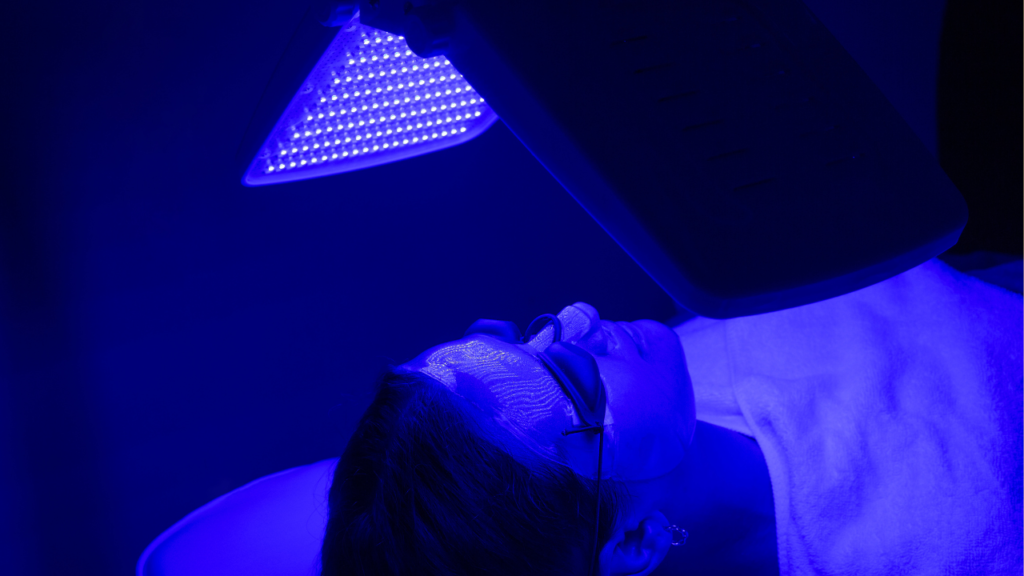
Get ready to embark on a promising journey towards holistic and non-invasive healing with the magic of red and near-infrared light therapy for photobiomodulation. Photobiomodulation therapy is not just a passing fad it’s the future of medicine and a sizzling hot choice in the wellness space!
The Power of Laser Exposure
Laser exposure has the potential to create a remarkable photobiomodulation effect on your precious cells and tissues. It’s like a superhero swooping in to positively influence cell behavior and lend a helping hand in the tissue repair process, working wonders by stimulating cellular rejuvenation, giving your body a much-needed boost, and contributing to your overall well-being.
The mesmerizing red and near-infrared light therapy awaits, ready to shower you with its rejuvenating and uplifting benefits. Get ready to embrace this incredible approach and experience the wonders of cellular renewal and tissue repair with Dr.Kaylee.
Maximizing Productivity with Photobiomodulation
- If you lead a busy schedule or are an entrepreneur, photobiomodulation therapy, specifically utilizing red light and near-infrared (NIR) light, presents an excellent opportunity to elevate your well-being. This cutting-edge approach proves highly effective in multiple aspects.
- Not only does it aid in tissue repair and reduce depression, but it also mitigates inflammation, bolsters energy levels, and enhances skin health. By seamlessly incorporating this therapy into your daily routine, you can optimize your productivity and effortlessly navigate the demands of your fast-paced lifestyle.
- Photobiomodulation, when applied to treat the brain, harnesses the power of red to near-infrared (NIR) light. This cutting-edge technique opens new doors in the treatment of various neurological conditions, including brain injuries, and even shows promise in addressing psychological well-being. It’s a game-changer that’s set to transform lives and pave the way for a brighter future.
What is Photobiomodulation?

Photobiomodulation, also known as red light therapy or near-infrared (NIR) light therapy, is a non-invasive therapeutic technique that utilizes specific wavelengths of light to stimulate cellular activity and promote healing in the body.
Let’s take a trip down memory lane to uncover the remarkable discovery of photobiomodulation (PBM), which traces its roots back nearly half a century. We owe this incredible breakthrough to the brilliant Endre Mester from Hungary. Initially known as “low-level laser therapy,” PBM started its journey with the help of impressive ruby lasers (694 nm) and HeNe lasers (633 nm). These early devices were the pioneers, setting the stage for what was to come.
The photobiomodulation process involves the application of low-level red and near-infrared light to targeted areas of the skin, where the light is absorbed by cells and triggers various biological responses. Using photobiomodulation treatment wavelengths have been found to penetrate deep into the skin, reaching the underlying tissues, muscles, and even organs.
Applications of Photobiomodulation or Laser Light Therapy

These properties have been utilized and observed in the treatment of various diseases and conditions, including:
- Low level therapy reduces pain and inflammation associated with dental procedures, promoting tissue healing after oral surgeries, and treating oral mucositis.
- Photobiomodulation can stimulate hair follicles, promote hair growth, and improve scalp health. It is also used in the treatment of conditions like androgenetic alopecia (pattern baldness) and thinning hair.
- Photobiomodulation for the treatment of improving mood, reducing symptoms of depression, reducing pain, promoting relaxation, oxidative stress, and regulating mood-regulating neurotransmitters has great effects on overall health.
- Low level laser therapy can support faster recovery from intense workouts injuries, reduce muscle soreness, pain and inflammation also improve overall athletic performance.
- It can accelerate the healing process, promote the formation of new blood vessels, and improve the quality of healed tissue in conditions like diabetic ulcers, surgical wounds, and burns.
- It stimulates collagen production and treats skin conditions such as acne, wrinkles, and scars, and also promotes overall skin rejuvenation.
Red Light vs. Near-Infrared Light
Red light
- It is visible to human light from 639nm to 700nm.
- It works for working on fine lines, and wrinkles, also maintaining skin tone.
- It is absorbed externally by skin tissues, increasing collagen production and leading to faster skin healing. Because it emits shorter wavelengths.
- It exhibits excellent absorption by superficial tissues’ mitochondria but has limited penetration into deeper layers.
Near-Infrared Light
- Near-infrared light is invisible to human light from 700nm to 1200nm.
- It penetrates deeper into tissues, reduced joint pain, and energy production, and increased muscle recovery. Because it emits longer wavelengths.
- It has shown greater effectiveness in accelerating healing, especially for ligaments and tendinopathies.
- It works as an anti-inflammatory agent, promotes blood flow, and stimulates energy production on a cellular level.
Tips for using light therapy for seasonal affect disorder or S.A.D.
- Your light box should have a 10,000 lux exposure. (lux is the measure of light intensity). A sunny day with bright light is 50,000 lux or greater.
- Keep the box just a foot away and off to the side of your face
- You should absorb light from lamps for 30 minutes a day. You can get your half hour over several sittings.
- Get a portion of your daily dose before 10 a.m.
- Continue your beauty regime cleansing and moisture even when you are using light therapy.
Red light therapy for weight loss
Light therapy has indirect effects on weight management by affecting various bodily functions. This photobiomodulation treatment alone is not typically used as the primary method for weight loss. It has beneficial effects to regulate circadian rhythms, the internal biological clock that controls the sleep-wake cycle, and other physiological processes. Irregular sleep patterns or exposure to excessive artificial light at night causes obesity and weight gain.
Blue light affects suppress appetite, leading to decreased food cravings and reduced calorie appetite. This low-power laser has mood-enhancing effects by increasing serotonin levels and reducing seasonal affective disorder (SAD).
It has an indirect impact on weight management by minimizing emotional eating and healthy eating. It also increases energy levels which contribute to greater motivation for exercise and physical activity which helps to reduce inflammation in the gut and prevent the risk of SIBO and IBS.
Mechanisms of action using pbm light therapy at home

Select the right light
Invest in a light therapy lamp designed for home use that suits your needs. These lamps produce intense light that replicates the characteristics of natural sunlight. While buying a light for photobiomodulation therapy consider some factors, recommended usage time, light intensity, and particular benefits the device provides.
Determine the Best Time for Light Therapy
Recognize the optimal time of day for your (low-power laser) low power therapy sessions. For regulating the sleep-wake cycle, energy levels, and boosting mood many people find morning exposure is beneficial. However, timing depends on your goals.
Setup the pbm light therapy area
Find a peaceful and comfortable space in your home. Simply place the lamp at an appropriate distance and angle, typically within your line of sight, and sit near it for the recommended duration.
Be Consistent
Consistency is the key to getting the maximum beneficial effects of the photobiomodulation (pbm) process. Take regular sessions daily or as prescribed by a naturopathic doctor. Regular use of this power laser over an extended period for better results.
How light therapy stimulates mitochondria
When the body absorbs red and NIR light, it interacts with the mitochondria, the powerhouse of the cells. This interaction stimulates a series of cellular responses, including increased energy production, improved circulation, reduced inflammation, and enhanced tissue repair.
- When red and NIR light is absorbed by the body, it penetrates the skin and reaches the target tissue.
- The light is then absorbed by the mitochondria, which contain a molecule called cytochrome c oxidase. This molecule is responsible for the final step of the energy production process within the mitochondria.
- The absorption of red and NIR light by cytochrome c oxidase stimulates its activity, leading to increased energy production in the form of adenosine triphosphate (ATP is the energy currency of cells).
- By enhancing ATP production, red and NIR light therapy can boost cellular energy levels, providing additional resources for the body to perform its functions optimally.
- PBM has demonstrated neuroprotective effects by enhancing neuronal survival, reducing oxidative stress, and promoting the release of neurotrophic factors. It has shown potential in the treatment of neurological conditions such as stroke, traumatic brain injury, brain functions, and neurodegenerative disorders
Why Naturopathic Doctors Prefer Photobiomodulation
Naturopaths believe in supporting the body’s own healing mechanisms, and photobiomodulation aligns with this principle. Dr. Kaylee recommends this therapy for various health conditions during individualized treatment plans for patients.
This therapy can cause blood vessels to widen (vasodilation), which enhances blood flow to the treated areas. Improved circulation can deliver oxygen, nutrients, and other essential substances more efficiently to the cells, promoting tissue health and supporting the body’s natural healing processes.
What is our aim?
Our aim is to minimize the risk of adverse effects and prioritize therapies that have a favorable safety profile. One of the advantages of photobiomodulation is its non-invasive nature, as it does not involve surgery, drugs, or significant side effects. It is considered a safe and well-tolerated therapy that can be used in combination with other treatment modalities or as a standalone therapy.
We emphasize a holistic approach to health, focusing on treating the root causes of illness and supporting the body’s innate healing abilities. That’s why we prefer photobiomodulation therapy because it aligns with this philosophy. As it can potentially address multiple aspects of health, including cellular function, inflammation, and tissue repair.
Red light around 660nm is great for absorption to the mitochondria of superficial tissues, for supporting healing, but doesn’t penetrate really deep. Near Infrared wavelengths around 880-900nm are better for speeding healing, particularly for ligaments and tendonopathies or deeper tissues. .
Low Level Light Therapy

Dr. Kaylee recommends receiving low-level light therapy at a clinic more than buying a device for at-home use. In a clinical setting, with bigger panels that use a duo+ array of light wavelengths, you get a deeper penetration of light for more effective treatment of t sprains, strains, partial tears, psoriasis, as well as alopecia hair loss. The effectiveness of laser light therapy tends to improve with increased usage and higher dosage levels.
These devices have higher light intensities, options for specific wavelengths of light, or additional features. In the clinic, we will provide a more therapeutic effect because of the added laser proof and duo+ array of light wavelengths. The treatment room is designed to minimize external distractions and create a relaxing atmosphere.

